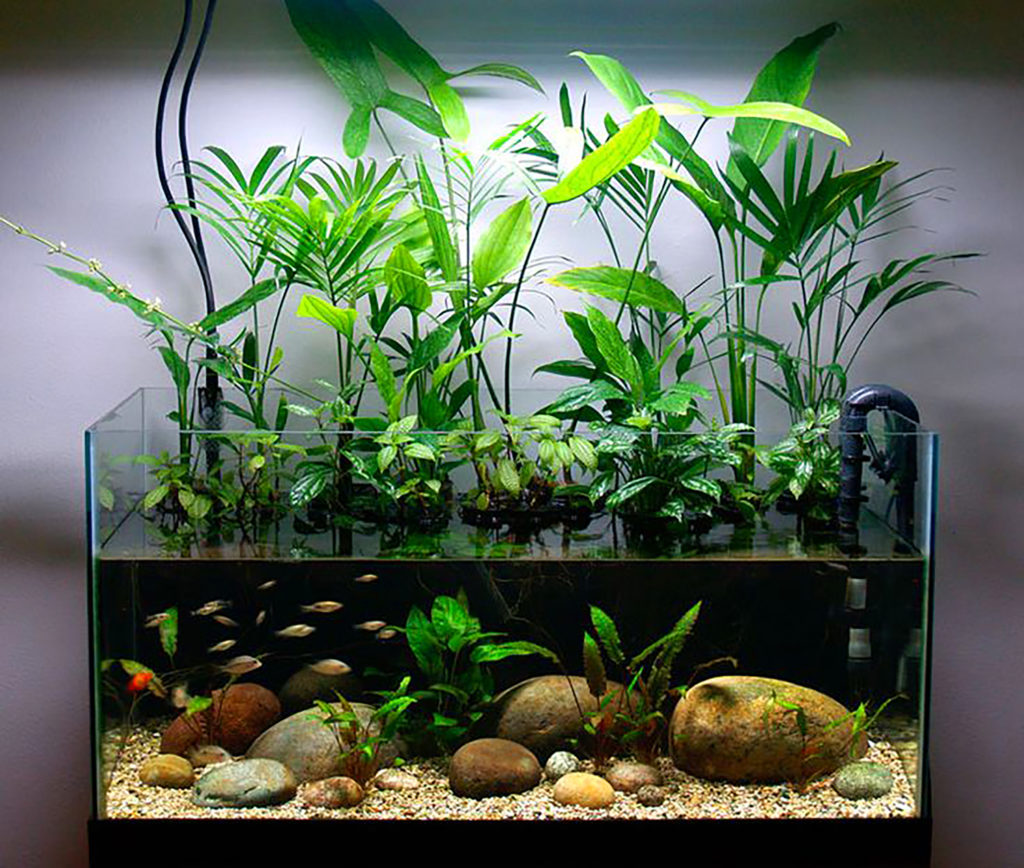
Riparium planting in 50-gallon with several selections found for sale as houseplants: Peace Lily (Spathiphyllum), Pilea grandifolia, Pilea cadierei and Chamaedorea cataractarum.
Like any engaging pastime attracting a crowd of devotees, aquascaping has specialized over time with distinct schools of thought and varied approaches. Dutch aquascapes emulate the orderly plant layouts of European gardens, while Nature Aquariums call to mind the art of bonsai or Japanese courtyard gardens. Biotope aquarists seek to capture snapshots of wild habitats with authentic combinations of livestock, plants and substrates. Planted ripariums, a more recently developed kind of aquascape, recreate the shoreline areas of aquatic habitats with plants growing both above and below the water surface.
In nature, this special zone hosts a unique assemblage of flora and fauna. Many of the most popular aquarium fishes live right along shorelines, where they find both abundant food and cover from predators. Shoreline plants and other species associated with water inhabit distinct kinds of plant microhabitat areas, including shallow water, swamps, stones in mountain streams, or acid bogs, but for the purposes of discussion, we can refer to them collectively to as marginal aquatics. Most marginal aquatics respond well to riparium cultivation and aquascaping techniques.
How Paludariums and Ripariums Differ
Another kind of aquascape, the paludarium, also mimics the shoreline zone, but paludariums and ripariums use distinct construction approaches. In a paludarium, a built-up soil and/or stone structure provides areas for planting, whereas ripariums use a trough or several planter boxes arranged along the rear glass panel. The 3-dimensional habitat features of a paludarium function as part of the visual design, but in a well-grown riparium the planters are hidden from view as the foliage develops. Because it can also incorporate an upland soil area (for true terrestrial plants) and aerial branch features (for epiphytic [tree-dwelling] plants), a paludarium can support a wider range of plant types than a riparium, but the selection of suitable plants for the wet shoreline zone overlaps for both kinds of setups. In other words, riparium plants also make great candidates for paludariums.
Riparium Plants from the Aquarium Trade
Since ripariums are a relatively new approach, hobbyists are still discovering new plant selections that adapt well with riparium care and visual design. Few catalogs list these plants specifically as riparium foliage but instead sell them for other kinds of gardening.
Among the best riparium choices are several popular aquarium plants. Shoreline areas create unique opportunities for plant growth and reproduction, just as they do for aquarium fishes. Because water depth may vary with topographic features and dry season-rainy season cycles, many of these plants have evolved to grow both above and below the water surface, sometimes requiring a transition period where existing leaves are replaced with either above water (emersed) or underwater (immersed) adapted foliage.
Several Echinodorus swordplants, especially E. cordifolius and its variegated cultivar, E. cordifolius ‘Tropica Marble Queen’, are excellent riparium choices when planted as emersed-adapted plants. Aquarium Cryptocoryne, Anubias and Java Fern (Microsorum) also make beautiful riparium plants if grown in a tank setup with a closed top to maintain the warm, high-humidity conditions of their wild habitats. A wide variety of aquarium stem plants, including Hygrophila, Bacopa, Ludwigia, and others, can add a rich variety of textures and colors to a planted riparium or paludarium when grown in an emersed state.
Finding Variety Beyond Aquarium Plants
While suitable aquarium plants can begin to fill out a riparium layout with their emersed foliage, an aquascaper may soon find that they do not really offer the full range of shapes, textures, colors or interesting natural history of the marginal aquatic plant zone in nature. Particular plant species or close approximations may also be desired for biotope representation. Where to look for more possibilities?
With the obvious similarities in growing conditions, there are several very good riparium choices usually sold as pond plants (a good topic for a future blog post!) and numerous others that have entered the horticultural trade as houseplants. Adaptable houseplants can usually be found easily, often inexpensively, and they are sold in mature, attractive condition. With careful shopping, houseplants can provide quick, easy, gratifying results in a riparium aquascape.
Just as is the case for submerged aquarium plants, it is a good idea to become familiar with the wild habitats and growing conditions in which marginal aquatics are to be used as riparium plants. The best selections are those plants that grow in association with water in the wild. While it may be possible to grow a Tomato plant hydroponically from the top of a fish tank, such a planting will neither visually resemble nor floristically represent a real streamside habitat. Houseplants originating from other than water-associated environments, such as succulents and epiphytic orchids, will likewise be quite out of place and less likely to adapt to riparium culture.
Just as submerged aquatic plants occur in a variety of underwater habitats and have correspondingly varied aquarium care requirements, riparium-suitable marginal aquatics will also vary in their culture. So it pays to dig even deeper into the ecology of these plants. As an example, while they may inhabit permanently wet situations, the roots of plants growing on cliffside seeps or among stream boulders develop in thin films of moving water with ample dissolved oxygen, a situation totally distinct from the oxygen-deprived root zone of muds in marshes and swamps.
The following short section describes several of the best houseplant choices for riparium aquascaping along with notes on their wild habitats and other details.
Adiantum Maidenhair Ferns
There are a few true swamp ferns that grow well in ripariums—Leather Fern (Acrostichum danaeifolium) is one of these—but most of the species cultivated as houseplants are terrestrials or epiphytes; plants like these will drown and die if you try to grow them in a riparium planter. Most of these are described as growing best in “moist” potting soil, but this kind of root environment is very different from a saturated, wet substrate. Among the houseplant Maidenhair Ferns (Adiantum), however, are some that grow on wet cliffs in the wild. Several hobbyists have achieved excellent results with Maidenhair Ferns rooted in riparium planters, where their delicate, lacy, spreading foliage fills out the lower realms of the planting and blends with the other foliage.
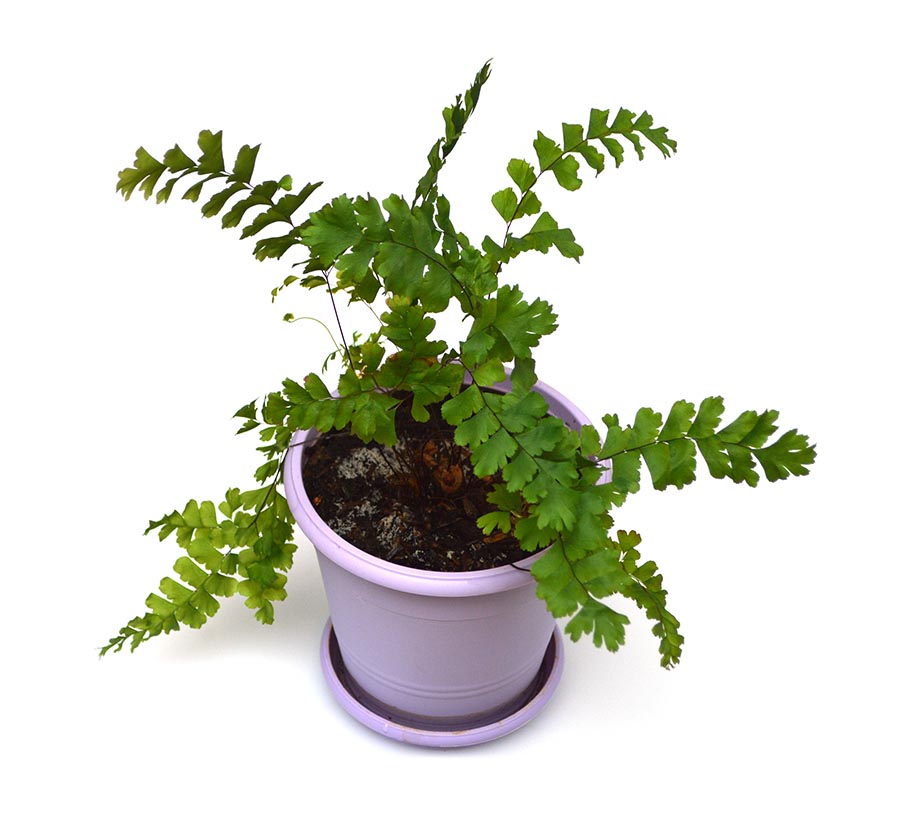
A commercially-cultured house plant being sold as the ‘Rosy Maidenhair Fern’, purportedly a variety of Adiantum tenerum. Image courtesy Matt Pedersen.
Tulip Anthurium
Most members of the diverse Neotropical aroid (Family Araceae) genus, Anthurium, grow as epiphytes on tall rainforest trees, but a few others are adapted instead as rheophytes, plants that grow on or among boulders in mountain streams. Among these is Anthurium amnicola, a plant native to Panama. Unfortunately, this species is extinct in the wild, but it has been crossed with other Anthurium to create dozens of easy-to-grow hybrids, now mass-produced in the houseplant trade as “Tulip Anthuriums” and sold in bloom almost everywhere. With their origin as a stream rheophyte, Tulip Anthuriums might grow best in a riparium planter with hydroton expanded clay balls or similar coarse substrate to facilitate free water diffusion through the root zone. The numerous Tulip Anthurium hybrid varieties have sturdy and compact aroid foliage and may bloom with long-lasting pink, red, white, lavender or purple aroid spathes, so a single plant may work well as a riparium layout centerpiece.
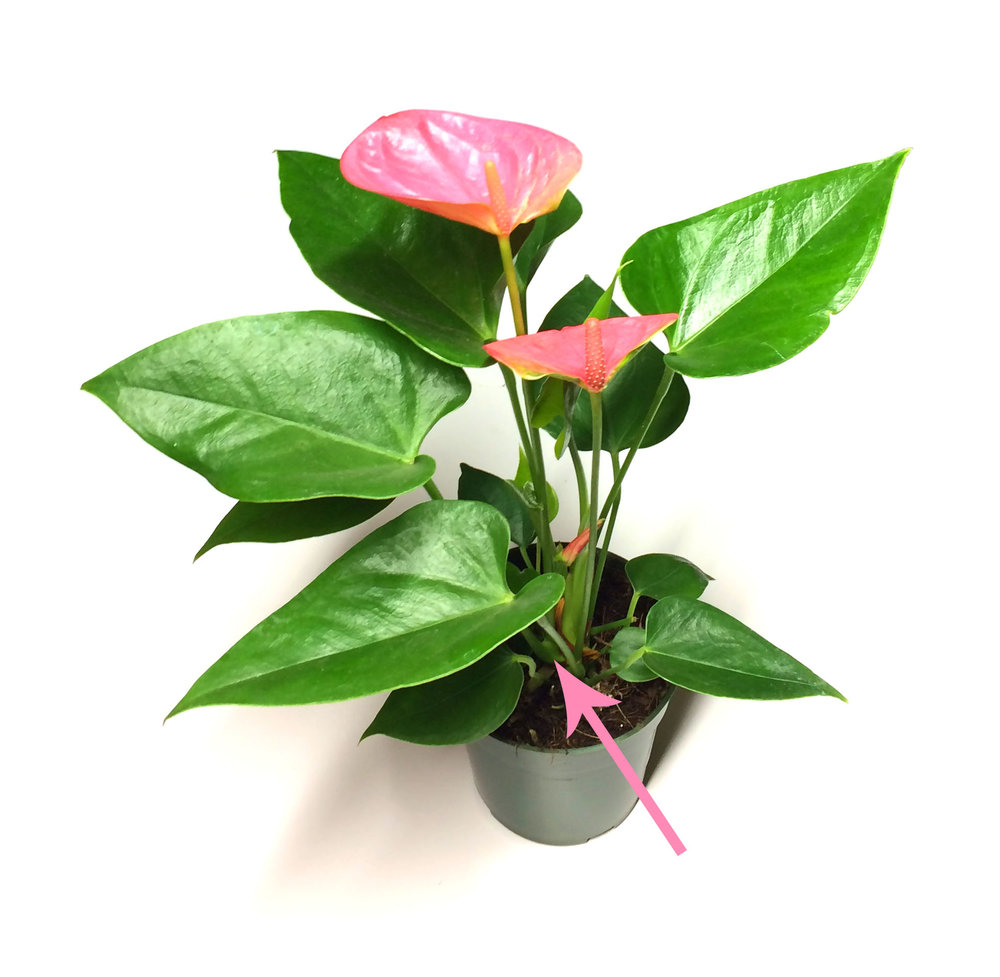
Tulip Anthurium in a 4-inch nursery pot. The potting mix with this plant should be rinsed away and long roots should be trimmed before planting in a riparium planter. A close inspection of the plant base (arrow) shows that it is growing as two individual crowns. These can be left together to make a bushier riparium plant, or carefully divided and replanted into two separate planters.
Epipremnum Pothos Vine
Many lowland tropical plants grow in rainforest areas well away from the river’s edge but are subject to floods that inundate their soils or submerge them completely when waters rise after rainy season deluges. Even though they are not necessarily associated with water habitats, such plants, including aroid vines, gingers, rainforest trees, lianas, and many others, can withstand a saturated root zone for an extended time. Pothos Vine (Epipremnum aureum) is an extremely common houseplant, probably the most ubiquitous of all, and grows well in riparium culture. Use it in combination with other tropical plants to represent the idea of a flooded rainforest. Since Pothos Vine cannot grow upright under its own support, give it branches to climb up and away from the water. You can also try this kind of care and display with Monstera, Rhaphidophora and Philodendron as other aroid climbers.
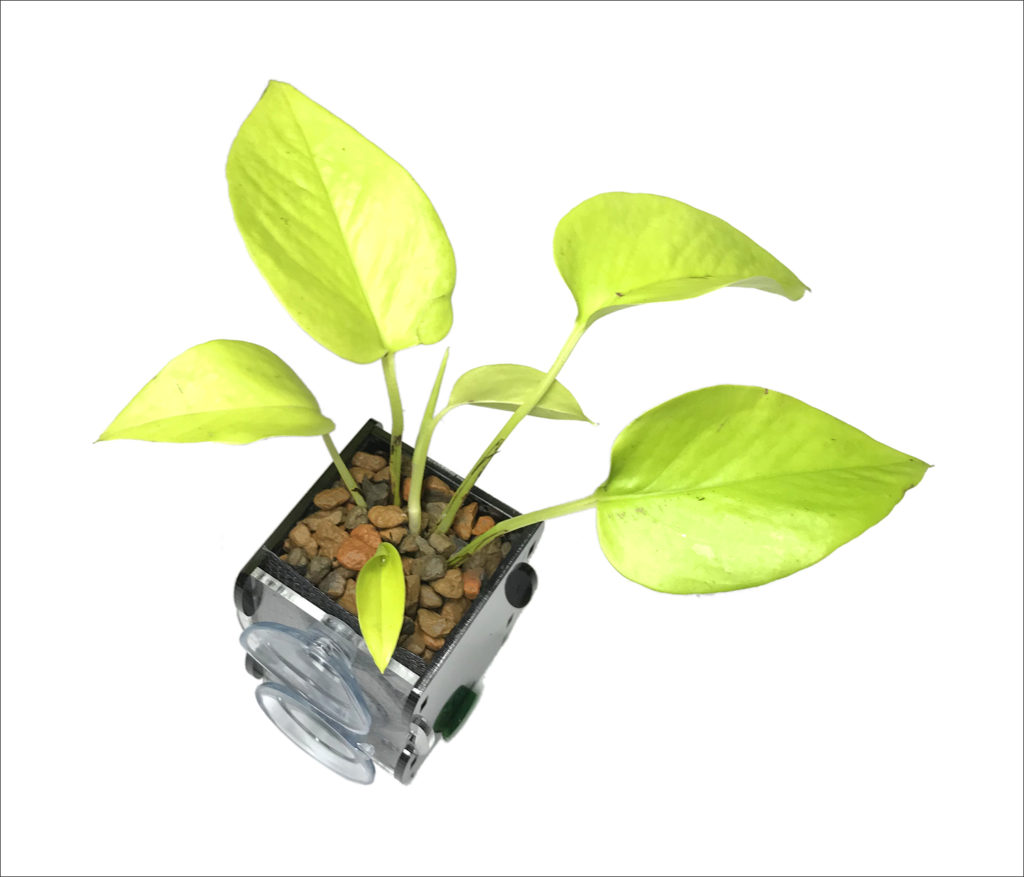
The lime green cultivated version of Pothos Vine (Epipremnum aureum ‘Neon’) in a riparium planter (Riparium Supply). Pothos Vine is among other tropical aroids that might grow best with extra water diffusion and more oxygen around the roots, so the planter was filled with a coarse expanded shale gravel.
Pilea Nettles
Members of the diverse Nettle Family (Urticaeae), a few species in Genus Pilea have entered the horticulture trade as compact houseplants with interestingly patterned leaves. While online descriptions provide rather sparse habitat information, quite a few Pilea and related plants grow in shaded tropical forest areas along springs, wet cliffs and rocky seeps. Aluminum Plant (Pilea cadierei) and Pilea mollis ‘Moon Valley’ both grow well when rooted in a riparium planter with hydroton expanded clay balls. It may take more searching to find, but the more reserved Pilea grandiflora also responds well to the same kind of care. With time, these plants may grow leggy and floppy as they reach for the light, but they are easily pruned back to encourage more bushy growth. Any pruned Pilea stem piece with a couple of leaf nodes will readily root when suspended in water.
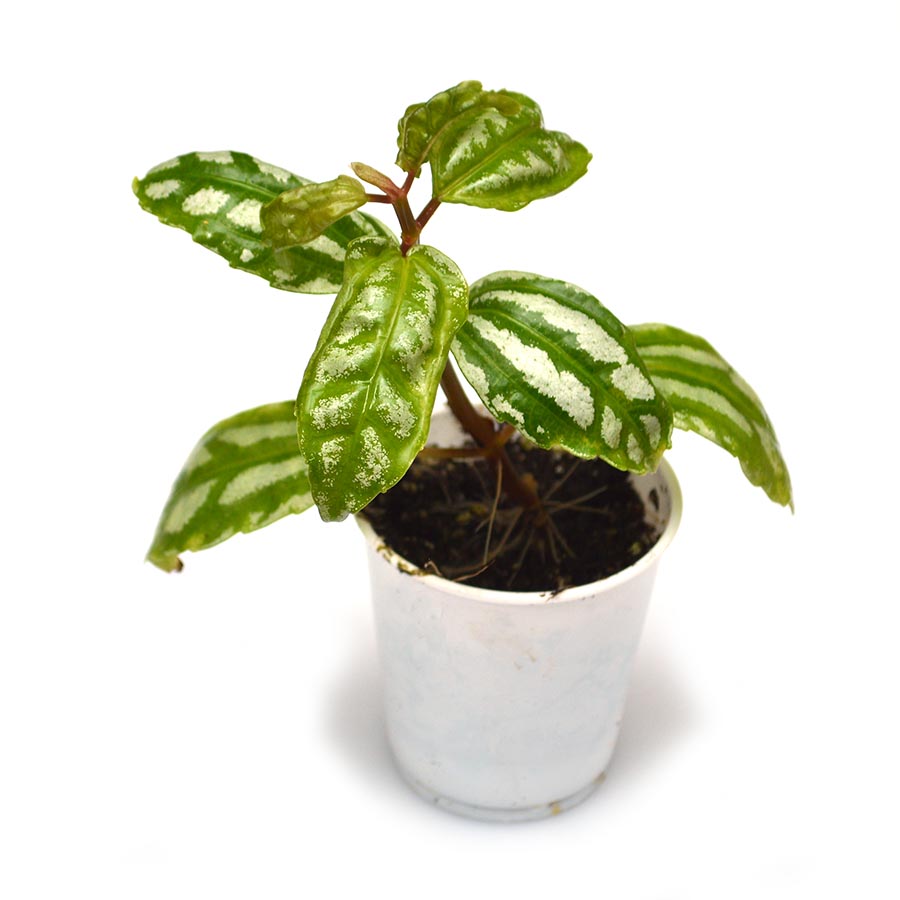
Aluminum Plant, Pilea cadierei, is generally seen in the aquarium trade as a bunch of cut stems bound together. A very poor choice for submersed use, it will excel as a riparium plant. Image courtesy Matt Pedersen.
Marantaceae Prayer Plants
Few other kinds of plants match the wild, psychedelic foliage colors and patterns of cultivated Calathea, Maranta and Stromanthe. Some members of Family Marantaceae grow in marshy or swampy tropical habitats, while others, especially the smaller, patterned species sold as houseplants, grow in rainforest areas subject to seasonal flooding. Prayer Plants can be fussy when grown indoors and may suffer in dry air, but will prosper in a riparium as evaporating tank water raises humidity around their foliage. It may take some more experimentation to find the Marantaceae species best adapted to riparium growing, but several hobbyists have already obtained good results with the striking Calathea lancifolia. Use a single Prayer Plant as a riparium centerpiece in combination with several taller Spathiphyllum or other green foliage plants to recreate a Central America or South America jungle streamside.
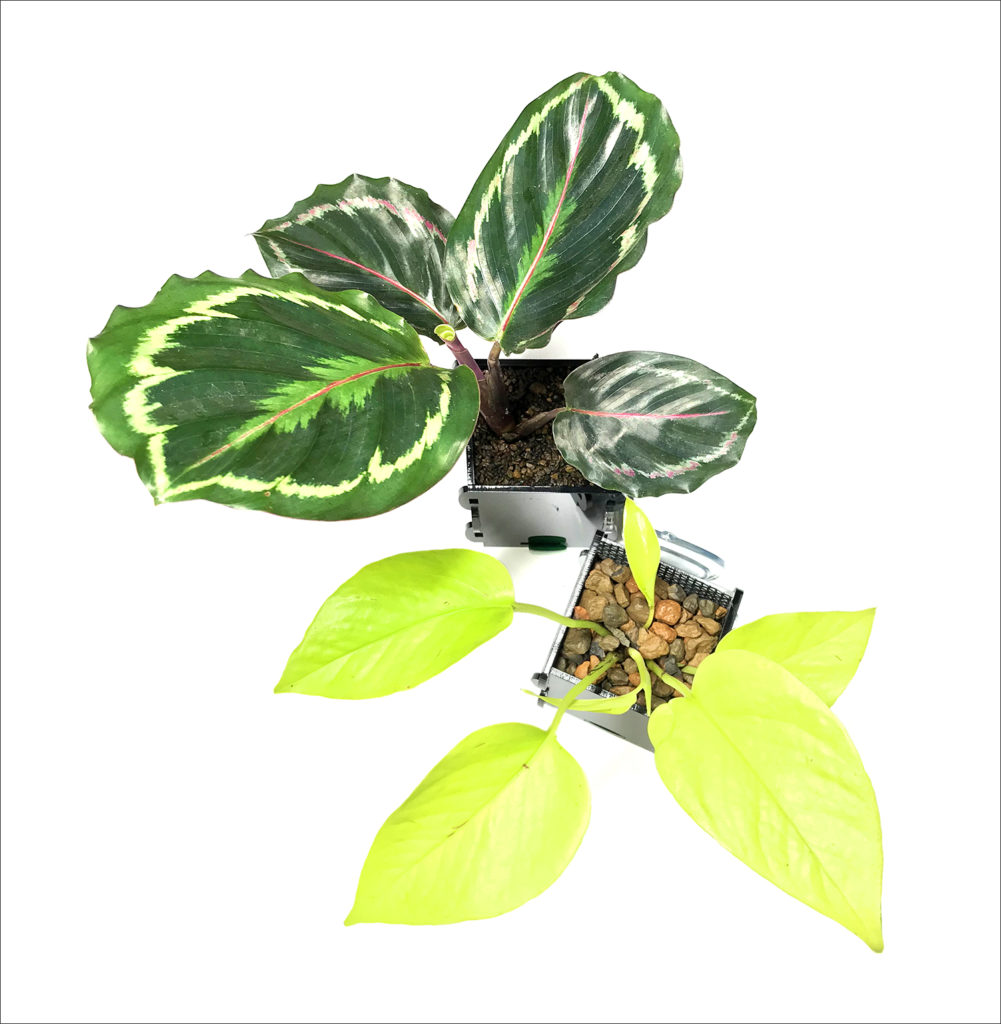
Prayer Plant (Calathea) (top) and Pothos Vine (Epipremnum aureum) in riparium planters (Riparium Supply). This bright lime green version of Pothos Vine sets up a nice contrast with the dark green Calathea. Notice that it also visually draws out the area of light green along near the margins of the Prayer Plant foliage.
Spathiphyllum Peace Lilies
Members of Genus Spathiphyllum are among the easiest and most versatile of riparium plants and among the most frequently encountered houseplants. In the wild, many of these Neotropical aroids grow in swampy rainforest areas along tropical mountain streams or close to rivers, so they are excellent candidates for biotope representation of these habitats. Many houseplant Spathiphyllum are apparently hybrids. I suspect that commercial growers in Florida and elsewhere have lost track of some of these names because the varied selections are most often listed simply as “Peace Lily”; it is rare to find one for sale as an actual species plant.
Look among plants in your local garden center for Spathiphyllum with leaf shape and size to suit your planted riparium project. The smallest Spathiphyllum may grow to only about 10″ (25cm) tall, a perfect size for a nano riparium planting, while others top 36″ (1m) and can fill out a planting in a very large riparium or indoor pond. Most Spathiphyllum are a neutral dark green color with sturdy, tidy, glossy leaves. Repeat them in several riparium planters as the main foliage background for a rainforest riparium and mix in other individual plants to contrast. There are a few Peace Lilies in the trade with variegated, lime green or white-patterned leaves. These may also be combined as single plants with several of the more standard dark green selections for eye-catching interest.
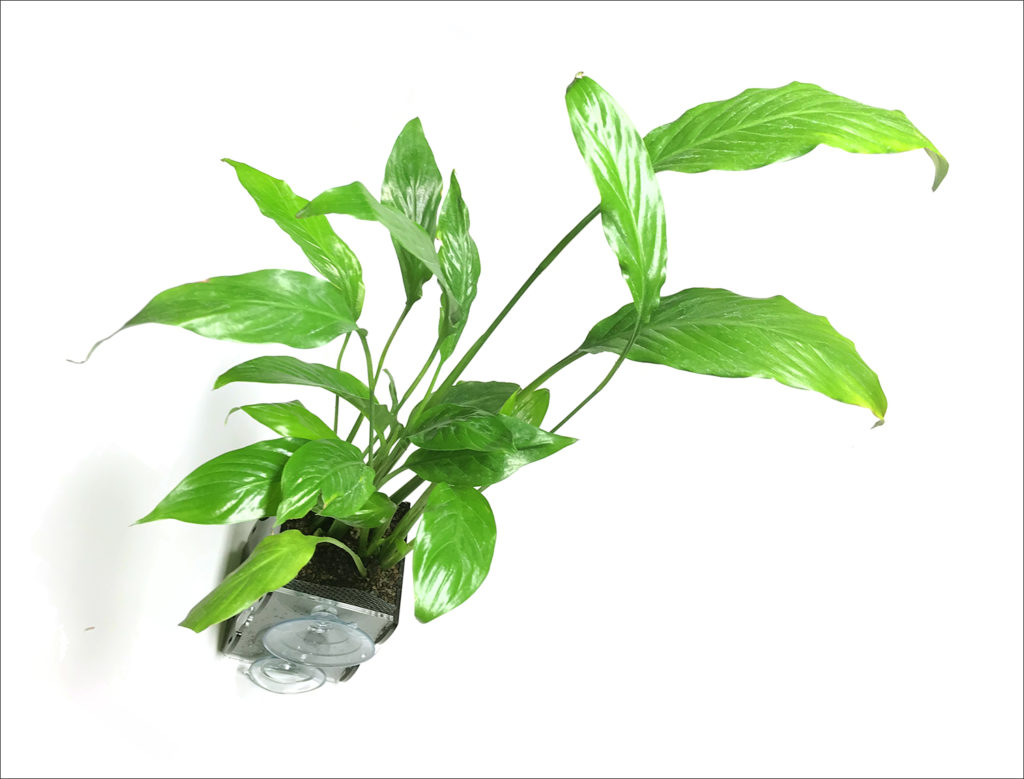
Spathiphyllum Peace Lily of an unknown cultivated variety in a riparium planter (Riparium Supply). This particular plant has graceful foliage with long leaf petioles. Peace Lily is among the easiest and most versatile of riparium plant choices.
Even More Riparium Options
This is only a partial list of houseplants that have been used in riparium aquascaping and there are many other possibilities that may be tried to expand the list of choices. The aroids, palms, tropical trees and robust tropical monocots (Heliconia, Musa, Zingiberaceae and others) are especially diverse, compelling groups to explore. However, before buying a new plant and plunging it into a fish tank riparium planting, research and learn as much as you can about its wild habitats and ecology. The Internet is notorious as a source of conflicting information, but a researcher can usually close in on the truth by cross-referencing and becoming familiar with the most reliable sources. With some luck and extra searching, you might also find more rigorous scientific publications in pdf form with details about ecology, plant classification and regional floras. This kind of preliminary work will both better the odds for success in riparium growing and enhance your understanding of fascinating, faraway ecosystems and the plants that grow in them.






Preciso de uma planta para um canto de sala com pouca luz, género Costela de Adão ou menos volumosa.